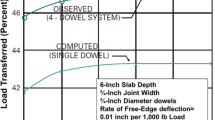Abstract
Concrete Block Paving (CBP) is widely used as wearing course in flexible pavements, preferably under light and medium vehicular loadings. Construction of CBP at site is quick and easy in quality control. Usually, flexible pavement design philosophy is followed in CBP construction, though it is structurally different in terms of small block elements with high strength concrete and their interlocking aspects, frequent joints and discontinuity, restrained edge etc. Analytical solution for such group action of concrete blocks under loading in a three dimensional multilayer structure is complex and thus, the need of conducting experimental studies is necessitated for extensive understanding of the load—deformation characteristics and behavior of concrete blocks in pavement. The present paper focuses on the experimental studies for load transfer characteristics of CBP under different interlocking and supporting conditions. It is observed that both interlocking and supporting conditions affect significantly on the load transfer behavior in CBP structures. Coro-lock block exhibits better performance in terms of load carrying capacity and distortion behavior under static loads. Plate load tests are performed over subgrade, granular sub-base (GSB), CBP with and without GSB using different block shapes. For an example case, the comparison of CBP with conventional flexible pavement section is also presented and it is found that CBP provides considerable benefit in terms of construction cost of the road structure.











Similar content being viewed by others
References
Bureau of Indian Standards (BIS). Specification for coarse and fine aggregates from natural sources for concrete. IS 383:1970, New Delhi, India (1970)
Bureau of Indian Standards (BIS). Recommended guidelines for concrete mix design. IS 10262:1982, New Delhi, India (1982a)
Bureau of Indian Standards (BIS). Method of load test on Soils. IS 1888:1982, New Delhi, India (1982b)
Bureau of Indian Standards (BIS). Specification for 33 grade ordinary portland cement. IS 269:1989, New Delhi, India (1989)
A.J. Clark, Block paving-research and development. Cem. Concr. Assoc. 12(7), 24–25 (1978)
A.J. Clark, Further investigations into the load spreading of concrete block paving. Technical report, TR 545, Cement and Concrete Association, U.K (1981)
Central Public Works Department (CPWD). Delhi Schedule of Rates. DSR 2013, New Delhi, India (2013)
Concrete Manufacturers Association. Concrete Block Paving. Concrete Manufacturers Association, Midrand, South Africa. Retrieved from http://www.pavecon.co.za/CMA_Concrete_Block_Paving_Book_1_Content.pdf (2009)
Indian Road Congress (IRC). Guidelines for the use of interlocking concrete block pavement. IRC SP 63:2004, The Indian Roads Congress, New Delhi, India (2004)
S.K. Khanna, C.E.G. Justo, Highway Engineering, 6th edn. (Nem Chand & Bros, Roorkee, 1990)
J. Knapton, S.D. Barber, The behaviour of a concrete block pavement, in Proceedings of Institute of Civil Engineers, London, 66-1, pp. 277–292, https://doi.org/10.1680/iicep.1979.2354 (1979)
W. Mampearachchi, A. Senadeera, Determination of the most effective cement concrete block laying pattern and shape for road pavement based on field performance. J. Mater. Civ. Eng. (2014). https://doi.org/10.1061/(asce)mt.1943-5533.0000801
Ministry of Road Transport and Highways. Specifications for Road and Bridge Works, 4th Revision, Indian Roads Congress, New Delhi, Govt. of India (2001)
Y. Miura, K. Yoshida, M. Komura, Y. Saeki, On the serviceability of concrete block pavements used on streets and bus bays, in Proceedings of the 2nd International Conference Concrete Block Paving, Delft, pp. 212–15 (1984)
M. O’Grady, Structural behaviour of concrete block paving. Transport Research Laboratory, pp. 17–18 (1983)
B.C. Panda, A.K. Ghosh, Structural behaviour of concrete block paving II: concrete blocks. J. Transp. Eng. ASCE 128(2), 130–135 (2002)
B.C. Panda, A.K. Ghosh, Structural behaviour of concrete block paving I: sand in bed and joins. J. Transp. Eng. ASCE 128(2), 123–129 (2002)
N. Pham, W. Lin, D. Park, H. Kim, Y. Cho, Evaluation methodology for laying pattern of interlocking concrete block pavements using a displacement-moment concept. J. Transp Eng (2013). https://doi.org/10.1061/(ASCE)TE.1943-5436.0000623
B. Shackel, The performance of interlocking block pavements under accelerated trafficking, in Proceedings of 1st International Conference on Concrete Block Paving, Newcastle-upon-Tyne, U.K., pp. 113–120 (1980)
B. Shackel, W. O’Keeffe, L. O’Keeffe, Concrete block paving tested as articulated slabs. in Fifth International Conference on Concrete Pavement Design and Rehabilitation, Purdue University, pp. 89–95 (1993)
B. Shackel, D.O.O. Lim, Mechanism of Paver Interlock, in Proceedings of the 7th International Conference on Concrete Block Paving, Sun City, South Africa (2003)
Y. Singh, T. Ryntathiang, K. Singh, An investigation of plastic cell filled concrete block pavement (PCCBP) overlay. J. Road Mater. Pavement Des. (2012). https://doi.org/10.1080/14680629.2012.676806
Author information
Authors and Affiliations
Corresponding author
Rights and permissions
About this article
Cite this article
Mahapatra, G., Kalita, K. Effects of Interlocking and Supporting Conditions on Concrete Block Pavements. J. Inst. Eng. India Ser. A 99, 29–36 (2018). https://doi.org/10.1007/s40030-018-0267-x
Received:
Accepted:
Published:
Issue Date:
DOI: https://doi.org/10.1007/s40030-018-0267-x




